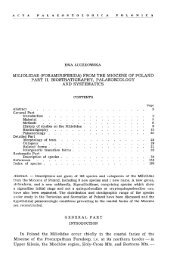Full text - Acta Palaeontologica Polonica
Full text - Acta Palaeontologica Polonica
Full text - Acta Palaeontologica Polonica
Create successful ePaper yourself
Turn your PDF publications into a flip-book with our unique Google optimized e-Paper software.
336 ACTA PALAEONTOLOGICA POLONICA 56 (2), 2011<br />
shells, display very similar residual patterns. Consequently,<br />
our personal opinion is that the discrimination of these three<br />
species is probably not justified.<br />
Genus Globularia Swainson, 1840<br />
Type species: Globularia sigaretina (Lamarck, 1804), Grignon, Lutetian.<br />
Description.—This genus is here considered to comprise three<br />
subgenera (Globularia, Deshayesia, andCernina) with 20<br />
species (16 Palaeogene species, 3 Neogene and one extant;<br />
SOM 1). The taxa Globularia, Cernina,andDeshayesia have<br />
not always been regarded as congeneric (Wrigley 1946). Nev−<br />
ertheless, the very similar residual colour patterns of 11 of the<br />
15 studied species (zigzagging axial fluorescent stripes; SOM<br />
2; Fig. 4, 5) strengthens the initial impression based on the<br />
shell morphology (wide aperture with prosocline outer lip,<br />
low spire and expanded sheath delineated by a rim) that they<br />
are closely related (Cossmann and Peyrot 1919; Wenz 1941).<br />
Thus, thanks to the additional character, all these species are,<br />
here, no longer considered to belong to distinct genera but are<br />
placed within the genus Globularia (senior synonym).<br />
Subgenus Globularia Swainson, 1840<br />
Globularia (Globularia) sigaretina (Lamarck, 1804)<br />
Fig. 4A–C.<br />
Stratigraphic and geographic range.—Middle Eocene, Lute−<br />
tian–Bartonian (PB, HB).<br />
Colour pattern description.—The shells show four levels of<br />
residual colouration. The background is often dark and ho−<br />
mogeneous (Fig. 4A, C), but it can be heterogeneous with<br />
slightly fluorescent broad spiral stripes (Fig. 4B). The apex is<br />
pale and there are fluorescent axial thin zigzagging stripes<br />
superimposed on the background (Fig. 4A, C). The transition<br />
between the two levels of residual colouration of the back−<br />
ground is diffuse. Zigzags occur along the whole height of<br />
the stripes and have variable amplitude (Fig. 4A). The den−<br />
sity of the zigzags varies with the specimens. One specimen<br />
shows an additional fluorescent spiral stripe (Fig. 4C) on the<br />
base of the shell. This residual colour pattern is very similar<br />
to that of Globularia (G.) berthelini (Cossmann, 1892) from<br />
the Lutetian of the Paris Basin (Fig. 4D–F).<br />
Globularia (Globularia) patula (Lamarck, 1804)<br />
Fig. 4G–L.<br />
Stratigraphic and geographic range.—Middle Eocene, Lute−<br />
tian–Bartonian (PB, HB).<br />
Colour pattern description.—The pattern consists of four<br />
levels of residual colouration. The background is heteroge−<br />
neous with two broad slightly fluorescent diffuse spiral stri−<br />
pes on the adapical and adbasal parts of the whorl (Fig.<br />
4I–L). The apex is pale and there are one (Fig. 4I–K) or two<br />
(Fig. 4G, H, L) fluorescent sharply delineated spiral stripes<br />
superimposed on the background. These two straight fluores−<br />
cent spiral stripes, superimposed on the dark median “stripe”<br />
of the background, are located near its adbasal margin and on<br />
its adapical margin. They do not become diffuse through<br />
ontogenesis. The adapical one is absent in the shells showing<br />
only one stripe (Fig. 4I–K).<br />
Globularia (Globularia) semipatula (Deshayes, 1864)<br />
Fig. 4M.<br />
Stratigraphic and geographic range.—Late Palaeocene,<br />
Thanetian–Middle Eocene, Ypresian (Cuisian) (PB).<br />
Colour pattern description.—This species shows three lev−<br />
els of residual colouration. The background is dark and ho−<br />
mogeneous. The apex is pale and there are axial thin fluores−<br />
cent zigzagging stripes (Fig. 4M). The axial thin stripes pres−<br />
ent a regular distribution. The zigzags occur along the whole<br />
height of the stripes and display variable amplitude. There is<br />
intraspecific variability in the number and density of the ax−<br />
ial thin stripes. This residual colour pattern is very similar to<br />
those of Globularia (G.) splendida (Deshayes, 1864) from<br />
the Ypresian of the Paris Basin (Fig. 4N) and Globularia (G.)<br />
patuloides (Cossmann, 1902) from the Bartonian of the Paris<br />
Basin (Fig. 4O).<br />
Globularia (Globularia) peyreirensis (Cossmann<br />
and Peyrot, 1919)<br />
Fig. 5A.<br />
Stratigraphic and geographic range.—Late Oligocene, Chat−<br />
tian–Early Miocene, Aquitanian (AB).<br />
Colour pattern description.—The shell displays only two<br />
levels of residual colouration (apex absent). The background<br />
is dark and homogeneous. There are numerous axial fluores−<br />
cent thin zigzagging stripes (Fig. 5A). The zigzags occur<br />
along the whole height of the stripes and have variable ampli−<br />
tude. The thin stripes are not strictly parallel and connect to<br />
each other at several points. These connections produce the<br />
occurrence of large fluorescent “patches” (Fig. 5A1, A2). ?Globularia pilula (Deshayes, 1864)<br />
Fig. 5B, C.<br />
Stratigraphic and geographic range.—Middle Eocene, Lute−<br />
tian (PB).<br />
Colour pattern description.—The colour pattern consists of<br />
three levels of residual colouration: a dark and homogeneous<br />
background, a pale apex and some thin fluorescent axial<br />
stripes forming zigzags (Fig. 5B 2, C). The axial thin stripes<br />
are not parallel and present an irregular distribution. The zig−<br />
zags occur along the whole height of the stripes and display<br />
variable amplitude. There is intraspecific variability in the<br />
density of axial stripes (Fig. 5B 2, C 2).<br />
Comments.—?Globularia pilula has been previously classi−<br />
fied in the naticid genus Euspira. These shells strongly differ<br />
from the type species of the latter genus, Euspira glaucinoides<br />
(Sowerby, 1812) from the Ypresian of England, in many char−<br />
acters (moderately high and acuminate spire, sutural step,<br />
minute umbilicus with no sheath and narrow reflected colu−<br />
mellar edge). Furthermore, the colour pattern differs from
















